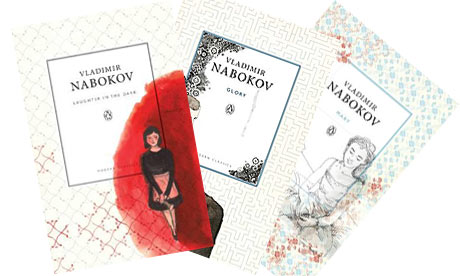
Fading into the wallpaper? ... Penguin's new Nabokov covers
It's official: the nation is in the grip of Naboko-fever. You can't open a newspaper, switch on the radio, or click open a Guardian blog without stumbling across a reference to the late great Vladimir Nabokov (see what I mean?). Like the Red Aztec Convertible forever lurking in Humbert Humbert's rear-view mirror, Nabokov seems to be everywhere right now. Which has got to be a Very Good Thing indeed. And to celebrate/contribute/capitalise on this frenzy for all things Nabokovian, Penguin are reissuing all of Nabokov's books – an act only the very churlish could possibly find something to complain about.
So here goes.
Maybe this is just a knee-jerk reaction against change (only time will tell) and perhaps I'm just being painfully precious and petty (wouldn't be surprised) but I have to say I'm not too keen on the covers of the reissues. To me, the books look like something you'd find either hung on the wall of a six-form art class, or resting on the bedside-table of a sickly Victorian child. They don't so much leap off the shelf as fade into the wallpaper. I can only assume that someone in the Penguin design team concluded that an insipid and watery pencil drawing was the best visual representation of a gorgeously lyrical prose style. Hopefully they'll have grown on me by the time they get round to reissuing the next batch. If not, I'll be disappointed, but not overly concerned. I'll simply sigh at a wasted opportunity and return to my battered, Sellotape-bound secondhand copy of Lolita (Berkley Publishing Corporation, Medallion Edition, Jan 1977). Which brings us to the point of this article: to me, this Berkley edition, with its plain black cover and flaming red text, IS Lolita. It looks dark and intimidating and has the whiff of the forbidden about it. Not that I'm suggesting book covers should imply elitism, simply that I cannot read Lolita without picturing this cover. It seems entirely apt for Humbert Humbert's deranged musings.
